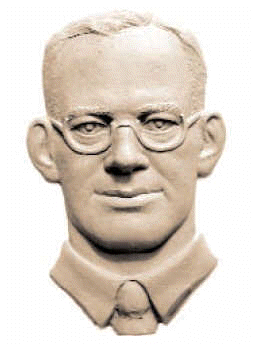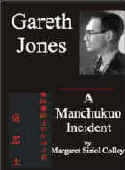Gareth Jones
[bas relief by Oleh Lesiuk]
HOME |
Stop Press |
Complete Soviet Articles & Background Information |
Précis of Gareth's
|
All Published Articles |
BOOKS
|
|
|
|
More Than Grain of Truth(2005) |
|
|
TOPICAL
'Are you Listening NYT?' U.N. Speech - Nov 2009 |
Gareth Recognised at Cambridge - Nov 2009 |
Reporter and the Genocide - Rome, March 2009 |
Order of Freedom Award -Nov 2008 |
Premiere of 'The Living' Documentary Kyiv - Nov 2008 |
Gareth Jones 'Famine' Diaries - Chicago 2008 |
Aberystwyth Memorial Plaque 2006 |
GENERAL
Scholarship Fund |
Site Map |
Links |
Legal Notices |
Sponsored Links |
Contact |
This article from Gareth's Scrapbook was dated in handwriting
as M.G. (Manchester Guardian) October 19th 1933 and underlined in pencil
.
THE
SOVIET COUNTRYSIDE: A TOUR OF INQUIRY
III.
Ukrainian District’s Good Harvest
(This is the third of five articles in which our Moscow correspondent, who has recently made a tour of some of the grain-producing areas of the Ukraine and North Caucasus, describes the result of his inquiries. The remaining articles will follow to-morrow and on Saturday.)
(From our Moscow Correspondent.)
POLTAVA.
This
Ukrainian town, picturesquely located on a hill above the Vorskla River, and
scene of one of the decisive battles of Russian history, when Peter the Great
smashed the invading forces of King Charles XII of Sweden, had a bad reputation
for hunger during the last winter and spring. Many of the rumours of
extreme hardship and suffering which reached Moscow centred around Poltava.
The
town at first sight showed no particular traces of the difficult winter through
which, by the general testimony of those citizens with whom I talked, it had
passed. The railway station was as clean as the average Soviet provincial
station, and there was a noteworthy absence of beggars and waifs. In
general it must be noted that even those regions which suffered most during the
last winter and spring show no tangible evidences of acute hunger at the present
time. This is very natural, because the autumn is always the most
favourable seasonal period for food supply. Fresh vegetables are available, and
‘the inflow of bread from the new harvest is felt by the peasant on the
collective farm and by the city employee ‘alike.
Poltava,
like every Soviet town, is on the Spartan food regime prescribed by the
ambitious efforts of the Five-year Plan. Meat and fats are extremely;
scarce, and the majority of the population has almost forgotten the taste of
sugar. But the bread ration is regular (three-quarters of a pound or a
Pound a day for employees, and double this amount for manual workers); factory
dining-rooms added to the fare of the workers in the larger and more important
enterprises (in the railway depot and goods yards, in the local bacon factory
and. metal works); and prices of bread sold apart from the rationed allotments
had declined from the dizzy scarcity heights of last winter to three roubles a
kilogram for semi-white and two roubles a kilogram for “black” or heavy rye
bread.
It
is quite impossible to translate the rouble into any accurate foreign currency
equivalent, but monthly wages in Poltava ranged, on the average, about 100
roubles a month. A visit to the local market revealed a fair supply of
Indian corn, cucumbers, tomatoes, and other vegetables, and some milk, but a
very meagre and unappetising supply of meat, while a solitary -chicken was
priced, at twenty-five roubles. Bread was sold only in State booths, as
the peasants are not allowed to sell it until the State grain collections, not
only for the Poltáva rayon, or district, but also for the much larger Kharkov
oblast, or territory, of which Poltava is a part, are completed.
A
visit to the Poltava market, where townsmen chaff eyed with kerchiefed peasant
women over the prices of eggs and - milk and vegetables, afforded a concrete
illustration of two important features of Soviet agricultural life - the State
control over the supply of staple foodstuffs and the tremendous decline in live
stock of Soviet agricultural life to-day.
EXCELLENT
HARVEST
With
a view to obtaining a general survey of local conditions I called on Mr. Mezhuev,
president of the local Soviet Executive Committee, which is housed in a spacious
building facing a park, probably the home of the governor-general of Tsarist
times. Mr. Mezhuev, a typical Ukrainian with black moustache, was
extremely kind and helpful, both in answering the questions which I put to him
and in facilitating two trips which I made outside the town to get an idea of
rural conditions.
He
characterised the harvest this year as excellent, averaging over twenty, bushels
an acre. The area planted in the spring was 37,500 hectares, double that
of last year despite the fact that the number of horses had declined from 8,000
to 4,800. Two important economic “campaigns,” one for grain deliveries
to the State, the other for the autumn planting, had been finished before the
end of September, whereas last year both had dragged on for a much longer period
of time.
“To
what do you attribute the improvement?” I inquired.
“Several
factors have been at work,” replied Mr. Mezhuev. “The establishment of a
fixed and unalterable grain levy; Stalin’s declaration that it is our ideal to
make all collective farmers well-to-do ; ‘more concrete and practical
leadership of the collective farms ~by, the party and Soviet authorities.”
FARM
ORGANISATION
Mr.
Mezhuev gave several examples of improvements in the organisation and management
of the collective farms and of the new emphasis on quality of agricultural
performance. In the first years of collectivisation attention was concentrated
on driving up the figures of land und~ cultivation; the quality if ploughing,
sowing, ‘and other operations was largely neglected. Now every field
must pass the test of examination by a State commission, which decides whether
it has been properly ploughed and whether it is reasonably free from weeds.
If the field is rejected it must be ploughed over. In the beginning there
was much looseness and uncertainty as to the amount of work assigned to each
member of a collective farm and as to the remuneration which he should receive.
Now the collective farmers are divided into brigades of approximately fifty
members each for the main field work. Each brigade is put to work on a
definite piece of land and kept there until all the harvesting operations are
completed; its payment is higher or lower, depending on whether it exceeds or
falls below the average harvest yield on this ‘land for the past seven years.
There
is’ a similar’ fixing of responsibility in regard to the handling of the
horses. In earlier years’ many horses were maltreated and neglected
because the peasant, accustomed to take good care of his own horse, was quite
in. different to the welfare of the socialised horse in the collective farm
stable. Now there are regular grooms who must see to it that every horse
has his proper individual harness and who must report any case of bad treatment
or neglect of the animals by the collective farmers who are using them.
Last, but not least, the labour discipline’ and moral have been strengthened
through’ the institution of the so-called political departments, the
functioning of which will be described in more detail in the following article.
DEATHS
FROM STARVATION
“What
is the truth of rumours about food shortage in the Poltava district last winter
and spring ?” I inquired.
“Elements
of hunger (elementi goloda) there were,” replied. Mezhuev, weighing his words
carefully. “There deaths from hunger. But the stories in the
émigré press about wholesale starvation are nonsense. The best
refutation is our successful spring planting and our good harvest.”
The
president of the Executive Committee then outlined interesting details of the
relief work which had been organised in the district. Two thousand
homeless peasant children hid been picked up: 1,500 of these were distributed
among families which were willing to care for them in the collective farms,
while 500 were organised in children’s commune. This, of course, went
far to explain the non-appearance of waifs, of whom there were so many after the
civil war and the famine of 1921. Six thousand collective farm members had
been sent to the coalmines of the Donetz Basin where they could find bread and
work; 2 400 persons suffering from acute mal-nutrition were treated at central
medical point: Of these about 10 percent died. These establishments
Mr: Mezhuev declared, reach every case, and my own observation in travelling
about the district was that relief was decidedly more accessible to the
12.000’peasant families of the district which are now organised in Collective
farms than to the, 2,500 families which still maintained individual farming.
[This article was dated in handwriting by Gareth as M.G. (Manchester Guardian) October 19th 1933 and underlined in pencil.]
|
|
|
|



